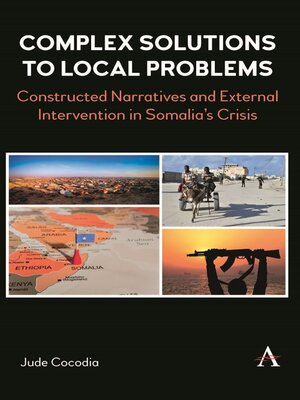Complex Solutions to Local Problems
ebook ∣ The Dilemma of the African Union in Somalia · Anthem Studies In Peace, Conflict and Development
By Jude Cocodia

Sign up to save your library
With an OverDrive account, you can save your favorite libraries for at-a-glance information about availability. Find out more about OverDrive accounts.
Find this title in Libby, the library reading app by OverDrive.



Search for a digital library with this title
Title found at these libraries:
| Library Name | Distance |
|---|---|
| Loading... |
This book examines Indigenous alternative solutions to the conflict in Somalia that were available prior to the African Union's (AU) peacekeeping operation – AMISOM. Bearing the long-standing stalemate with Al-Shabaab, this book contends that the AU should retrace its steps and utilise these Indigenous approaches else it would lose out in a protracted war. AMISOM was a product of the extremely biased mainstream/Western narrative that has done great harm on the continent. So it is high time Africans tell their story of what the issues really are and encourage its IGOs to do the same in addressing issues on the continent, Somalia inclusive. The Single Story Thesis was the method of analysis adopted for this book.
|This book is divided into three sections.
The first section examines the political relationships/structures of Somalia's clans with focus on the pre–Siad Barre era. Somalis are largely one people further linked by one religion (Sunni Islam). Establishing their connectivity is crucial in view of this project's contention that Indigenous methods of conflict resolution that have so far worked in the north (Somaliland and Puntland) can work in the south-central regions where conflict still pervades.
The next section examines the conflict in Somalia from events leading to the exit of Siad Barre (the point where the conflict really begins) and the growth of the Aristocratic/Gerontocratic system of government in the north to address the situation. It will capture the rise of the Islamic Courts Union (ICU) in the south-central areas whose aim was the stability of the regions under their control. The gains, gaps and setbacks of these Indigenous systems will also be discussed in this section.
The third section captures the intervention of Ethiopia and the United States in Somalia's conflict and how the African Union (AU) was drawn into the fray to legitimize this intervention. Here the book deals with the following (research) question: Should the AU have gone ahead with the intervention plans of the US/Ethiopia that were directed at debilitating the ICU, or, should focus have been directed at supporting local structures put in place by the ICU to foster stability as had been done in the north by the clan elders? This section discusses the current state of affairs in view of what was forfeited.







